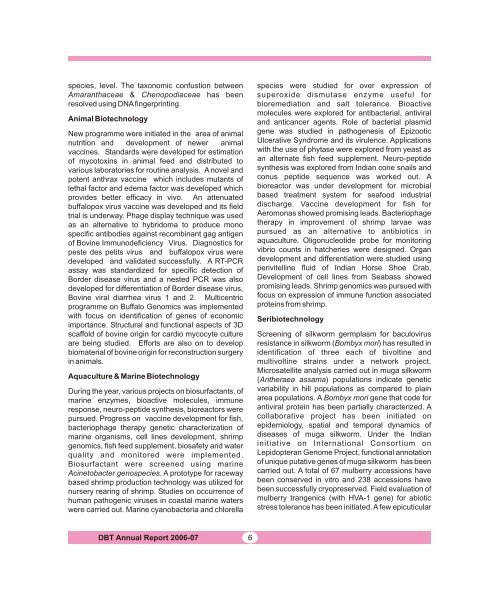ANNUAL REPORT - Department of Biotechnology
ANNUAL REPORT - Department of Biotechnology
ANNUAL REPORT - Department of Biotechnology
You also want an ePaper? Increase the reach of your titles
YUMPU automatically turns print PDFs into web optimized ePapers that Google loves.
species, level. The taxonomic confustion between<br />
Amaranthaceae & Chenopodiaceae has been<br />
resolved using DNA fingerprinting.<br />
Animal <strong>Biotechnology</strong><br />
New programme were initiated in the area <strong>of</strong> animal<br />
nutrition and development <strong>of</strong> newer animal<br />
vaccines. Standards were developed for estimation<br />
<strong>of</strong> mycotoxins in animal feed and distributed to<br />
various laboratories for routine analysis. A novel and<br />
potent anthrax vaccine which includes mutants <strong>of</strong><br />
lethal factor and edema factor was developed which<br />
provides better efficacy in vivo. An attenuated<br />
buffalopox virus vaccine was developed and its field<br />
trial is underway. Phage display technique was used<br />
as an alternative to hybridoma to produce mono<br />
specific antibodies against recombinant gag antigen<br />
<strong>of</strong> Bovine Immunodeficiency Virus. Diagnostics for<br />
peste des petits virus and buffalopox virus were<br />
developed and validated successfully. A RT-PCR<br />
assay was standardized for specific detection <strong>of</strong><br />
Border disease virus and a nested PCR was also<br />
developed for differentiation <strong>of</strong> Border disease virus,<br />
Bovine viral diarrhea virus 1 and 2. Multicentric<br />
programme on Buffalo Genomics was implemented<br />
with focus on identification <strong>of</strong> genes <strong>of</strong> economic<br />
importance. Structural and functional aspects <strong>of</strong> 3D<br />
scaffold <strong>of</strong> bovine origin for cardio mycocyte culture<br />
are being studied. Efforts are also on to develop<br />
biomaterial <strong>of</strong> bovine origin for reconstruction surgery<br />
in animals.<br />
Aquaculture & Marine <strong>Biotechnology</strong><br />
During the year, various projects on biosurfactants, <strong>of</strong><br />
marine enzymes, bioactive molecules, immune<br />
response, neuro-peptide synthesis, bioreactors were<br />
pursued. Progress on vaccine development for fish,<br />
bacteriophage therapy genetic characterization <strong>of</strong><br />
marine organisms, cell lines development, shrimp<br />
genomics, fish feed supplement, biosafety and water<br />
quality and monitored were implemented.<br />
Biosurfactant were screened using marine<br />
Acinetobacter genospecies. A prototype for raceway<br />
based shrimp production technology was utilized for<br />
nursery rearing <strong>of</strong> shrimp. Studies on occurrence <strong>of</strong><br />
human pathogenic viruses in coastal marine waters<br />
were carried out. Marine cyanobacteria and chlorella<br />
DBT Annual Report 2006-07<br />
6<br />
species were studied for over expression <strong>of</strong><br />
superoxide dismutase enzyme useful for<br />
bioremediation and salt tolerance. Bioactive<br />
molecules were explored for antibacterial, antiviral<br />
and anticancer agents. Role <strong>of</strong> bacterial plasmid<br />
gene was studied in pathogenesis <strong>of</strong> Epizootic<br />
Ulcerative Syndrome and its virulence. Applications<br />
with the use <strong>of</strong> phytase were explored from yeast as<br />
an alternate fish feed supplement. Neuro-peptide<br />
synthesis was explored from Indian cone snails and<br />
conus peptide sequence was worked out. A<br />
bioreactor was under development for microbial<br />
based treatment system for seafood industrial<br />
discharge. Vaccine development for fish for<br />
Aeromonas showed promising leads. Bacteriophage<br />
therapy in improvement <strong>of</strong> shrimp larvae was<br />
pursued as an alternative to antibiotics in<br />
aquaculture. Oligonucleotide probe for monitoring<br />
vibrio counts in hatcheries were designed. Organ<br />
development and differentiation were studied using<br />
perivitelline fluid <strong>of</strong> Indian Horse Shoe Crab.<br />
Development <strong>of</strong> cell lines from Seabass showed<br />
promising leads. Shrimp genomics was pursued with<br />
focus on expression <strong>of</strong> immune function associated<br />
proteins from shrimp.<br />
Seribiotechnology<br />
Screening <strong>of</strong> silkworm germplasm for baculovirus<br />
resistance in silkworm (Bombyx mori) has resulted in<br />
identification <strong>of</strong> three each <strong>of</strong> bivoltine and<br />
multivoltine strains under a network project.<br />
Microsatellite analysis carried out in muga silkworm<br />
(Antheraea assama) populations indicate genetic<br />
variability in hill populations as compared to plain<br />
area populations. A Bombyx mori gene that code for<br />
antiviral protein has been partially characterized. A<br />
collaborative project has been initiated on<br />
epidemiology, spatial and temporal dynamics <strong>of</strong><br />
diseases <strong>of</strong> muga silkworm. Under the Indian<br />
initiative on International Consortium on<br />
Lepidopteran Genome Project, functional annotation<br />
<strong>of</strong> unique putative genes <strong>of</strong> muga silkworm has been<br />
carried out. A total <strong>of</strong> 67 mulberry accessions have<br />
been conserved in vitro and 238 accessions have<br />
been successfully cryopreserved. Field evaluation <strong>of</strong><br />
mulberry trangenics (with HVA-1 gene) for abiotic<br />
stress tolerance has been initiated. A few epicuticular

















